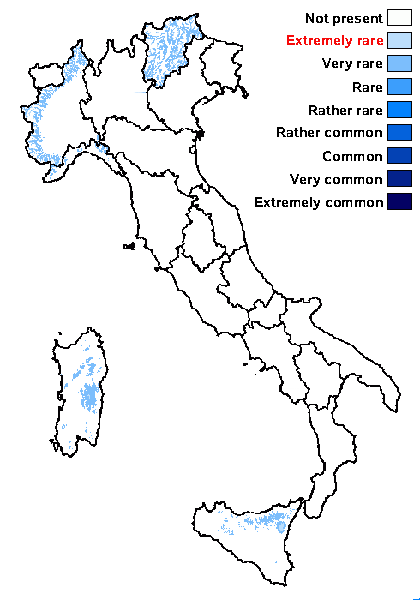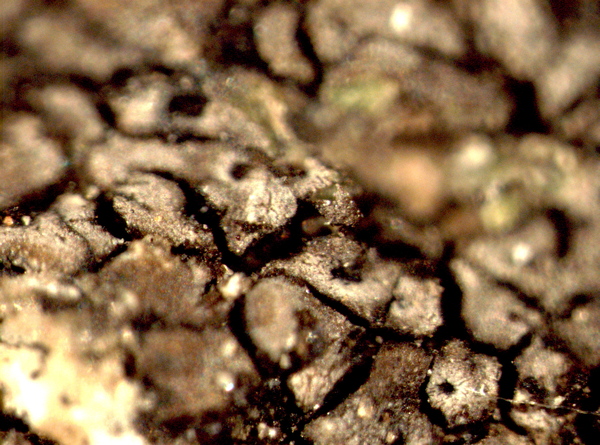Heteroplacidium compactum (A. Massal.) Gueidan & Cl. Roux
Bull. Inf. Ass. Franç. Lichén., 33, 1: 25, 2008. Basionym: Placidium compactum A. Massal. - Miscell. Lichenol.: 32, 1856.
Synonyms: Catapyrenium compactum (A. Massal.) R. Sant.; Dermatocarpon compactum (A. Massal.) Lettau; Dermatocarpon compactum var. eurysporum Lettau; Dermatocarpon crassulum (Müll. Arg.) Zahlbr.; Endopyrenium crassulum Müll. Arg.; Rhodocarpon compactum (A. Massal.) Lönnr.; Verrucaria compacta (A. Massal.) Jatta
Distribution: N - VG, TAA (Spitale & Nascimbene 2012, Nascimbene & al. 2022), Piem (Isocrono & al. 2004), Lig (Breuss 1994). C - Sar (Breuss 1994). S - Si.
Description: Thallus crustose-areolate to subsquamulose, medium to usually dark brown, smooth, dull. Areoles at first angular, then rounded, flat to slightly convex, to 4 mm wide and to 0.6 mm thick, sometimes sublobate and partly overlapping, constricted at base to form short peg-like projections composed of vertically oriented hyphae. Upper cortex paraplectenchymatous, of 5-8 µm wide cells, 10-25 µm thick, with a brown uppermost layer overlain by an up to 20 µm thick epinecral layer; medulla white, paraplectenchymatous; lower cortex absent. Perithecia immersed, 0.25-0.4 mm across, without involucrellum; exciple subglobose, colourless with only the apex brown-black, darkening throughout with age; hamathecium of periphyses and periphysoids, interascal filaments absent; hymenial gel hemiamyloid. Asci 8-spored, clavate, I-, fissitunicate, the wall thickened above, Verrucaria-type, 55-70 x 13-20 µm. Ascospores 1-celled, hyaline, broadly ellipsoid to subglobose, 13-18 x 8-10 µm, biseriately arranged in the asci. Pycnidia laminal, immersed, black, of the Dermatocarpon-type. Conidia bacilliform, 5-7 x c. 1.5 µm. Photobiont chlorococcoid (Myrmecia). Spot tests: cortex and medulla K-, C-, KC-, P-, UV-. Chemistry: without lichen substances.Note: on more or less calcareous rocks, sometimes on other crustose lichens, but not parasitic, usually in upland areas but below treeline. This name probably includes several taxa related to H. fusculum, whose taxonomic status is in need of clarification.
Growth form: Crustose
Substrata: rocks
Photobiont: green algae other than Trentepohlia
Reproductive strategy: mainly sexual
Poorly known taxon in need of further study
Commonnes-rarity: (info)
Alpine belt: absent
Subalpine belt: extremely rare
Oromediterranean belt: extremely rare
Montane belt: very rare
Submediterranean belt: absent
Padanian area: absent
Humid submediterranean belt: absent
Humid mediterranean belt: absent
Dry mediterranean belt: absent

Predictive model
Herbarium samples
Growth form: Crustose
Substrata: rocks
Photobiont: green algae other than Trentepohlia
Reproductive strategy: mainly sexual
Poorly known taxon in need of further study
Commonnes-rarity: (info)
Alpine belt: absent
Subalpine belt: extremely rare
Oromediterranean belt: extremely rare
Montane belt: very rare
Submediterranean belt: absent
Padanian area: absent
Humid submediterranean belt: absent
Humid mediterranean belt: absent
Dry mediterranean belt: absent

Predictive model
| Herbarium samples |
 INDEX FUNGORUM
INDEX FUNGORUM
 GBIF
GBIF
 DOLICHENS
DOLICHENS




